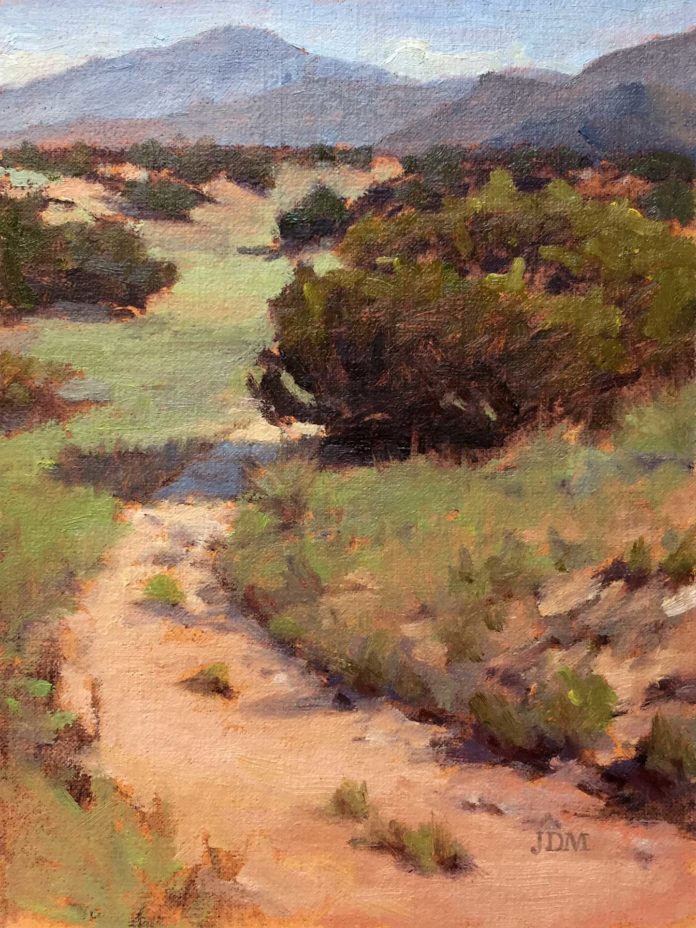Plein Air Painting in New Mexico’s High Desert
By John Meister, 2018 President of Plein Air Painters of New Mexico
Article originally published in 2018
We call it the “Land of Enchantment,” and some people get it the minute they step out of the airport. Others spend years here before they realize it is part of them. For the visitor, the ancient history, the amazing sites, and the diversity of culture, provide a host of experiences. This is a place where stories are born. This is New Mexico.
As for me, I grew up in Austin, Texas and have now lived in Albuquerque for 28 years. It is where much of my family is from, so we made the drive from Austin, across the West Texas plains and into a terrain full of features that intrigued a young boy looking out of the rear window.
The city of my childhood essentially had two halves of the year — sticky-green summer and dense-wet winter. Now, living in a place with four distinct seasons, I appreciate the small day-to-day changes between each of them, and how moisture, temperature, and wind are players in a game to sustain life or break it down. Everything, from plants to mountains, must have a little extra advantage to survive here, and it is their resilience in the face of decay that produces the extraordinary landscape that we painters enjoy.
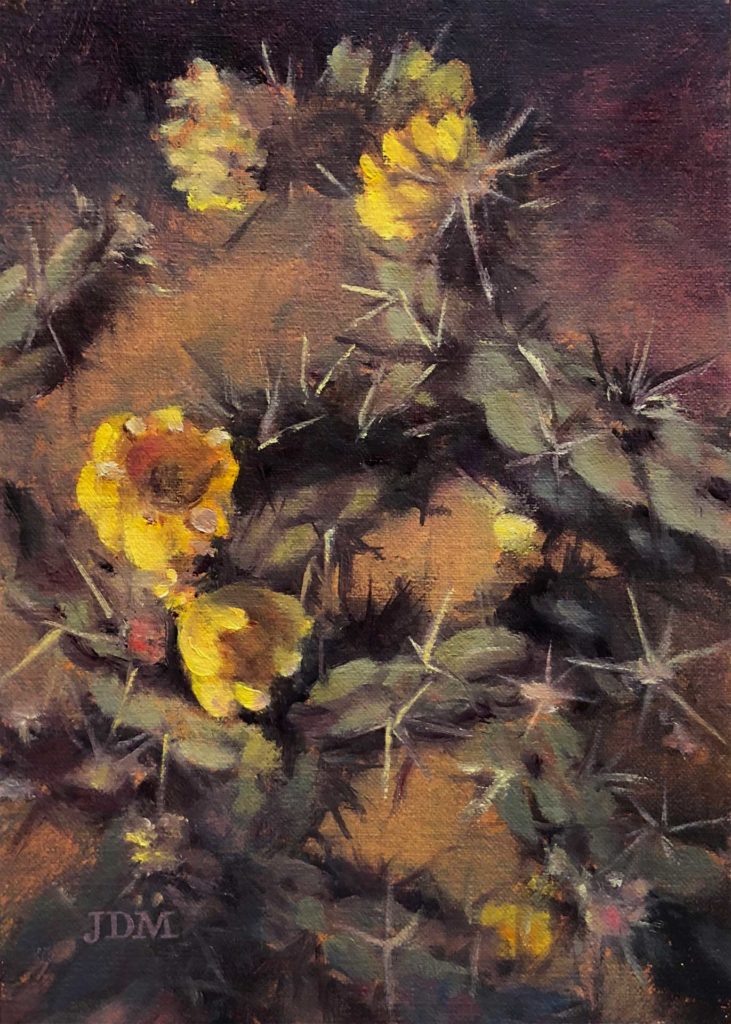
The rugged beauty of New Mexico attracts many plein air painters looking to find a unique muse, and while they might know that they come to a desert state, the label “desert” can be misleading. Sure, the term is an indication of our average annual rainfall, or lack thereof, but the high desert of New Mexico is full of unexpected life, color, and extremes.
Santa Fe, one of the top art markets in the country, resides a 50-minute drive north of Albuquerque, and in the middle of this ever-changing environment. Its bright floral gates provide aesthetic subject matter, and warm, meandering adobe walls cast shadows and pitch light from every direction, luring the artist to paint them. At this elevation, the zenith of the sky is a deep ultramarine, and an outdoor painter doesn’t need much training to see this blue openly reflected in shaded areas below.
[Join hundreds of other artists in Santa Fe at the next Plein Air Convention & Expo!]
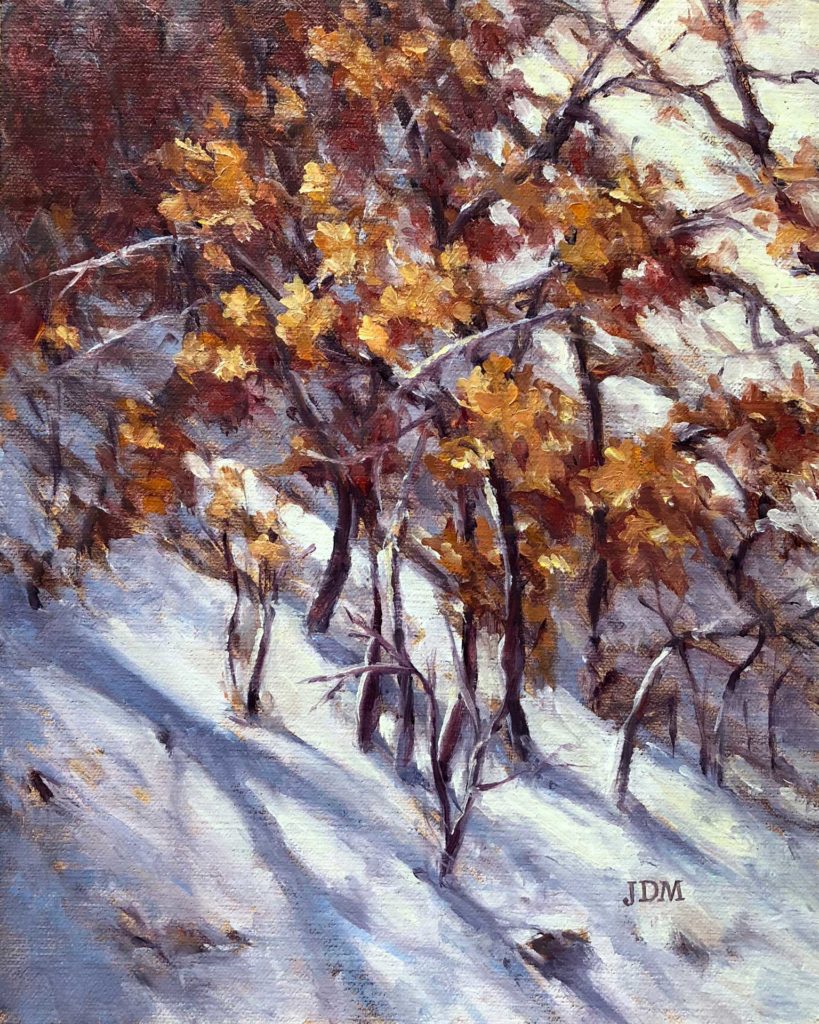
Visiting for the first time, people are surprised to learn that this charming Spanish colonial city, with its serpentine streets and smooth tan walls, sits at an elevation almost 2,000 feet higher than the Mile High City, Denver, Colorado. The crisp, dry air here feels like nature’s air conditioning, to those from more humid lowlands, but climbing a few steps into a cantina can leave one gulping for their next drink of oxygen. It is important to drink plenty of fluids in this arid climate, and hydrating a few days before coming to this area from lower elevations can help ward off the nausea and headaches of infrequent altitude sickness.
Springtime in New Mexico is a period of dramatic transformation from the dormancy of winter to the vibrant life of the warmer months, and in the higher elevations of the northern part of the state, April is right on the cusp of this change. We generally enjoy at least 10 months of sunshine per year, but temperatures can easily swing 40 degrees over the course of a day. And, although spring is typically a beautiful season, it is not uncommon to begin an April day here with snow (and a green chile breakfast burrito), then warm up to a clear sunny sky, then wind, then afternoon rain, then a beautiful sunset (may I suggest a margarita to go with your enchiladas?).
This is a classic plein air day, from my perspective — full of challenge and variety, where the weather moves in and out of fashion as quickly as a social media app. For the sky painter, cloud build-ups are fantastic this time of year, and with our wide-open vistas, you can sometimes see a hundred miles of them. Combine that with layer upon layer of mountains and mesas, and it is a feast of aerial perspective.
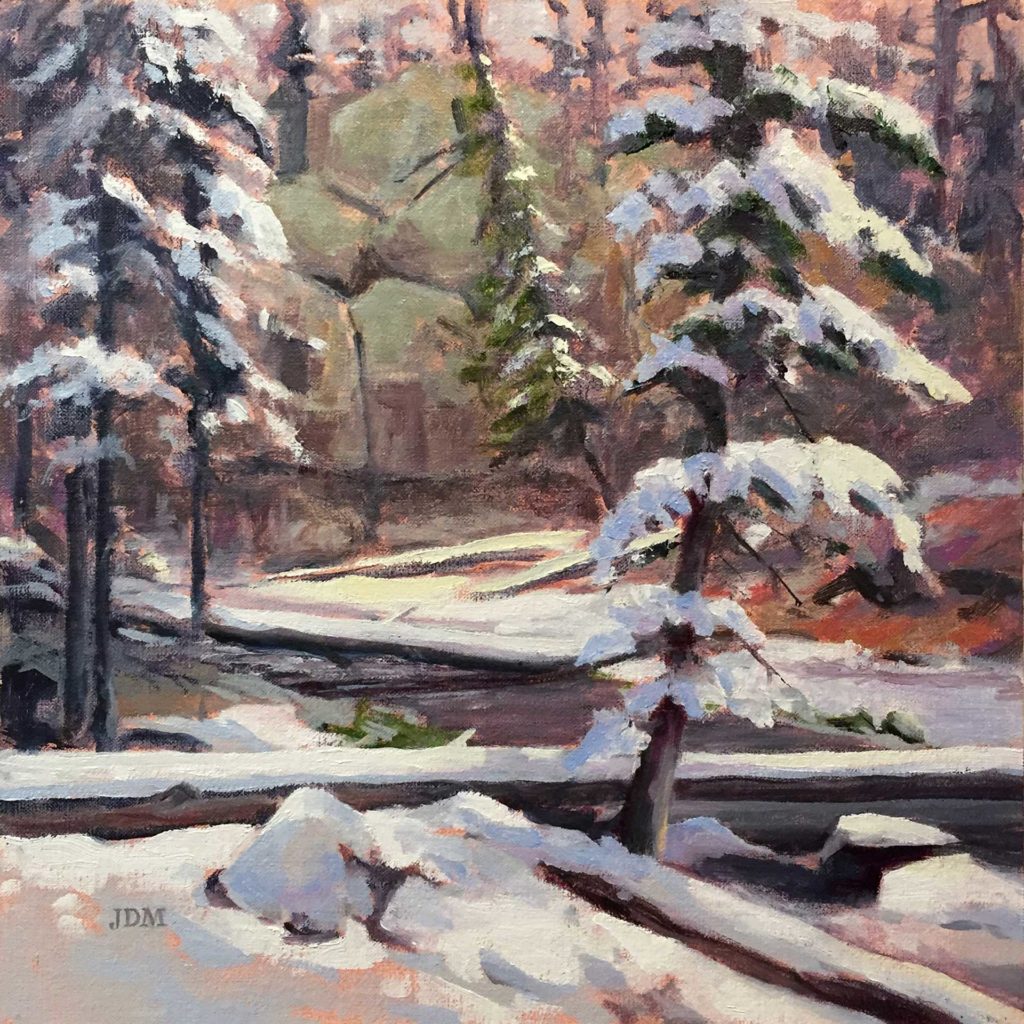
Plein Air Painting in New Mexico
Here are a few basics that the first-time high desert painter might find helpful. Let’s start at the top: wear a hat, wide-brimmed and protective. Yeah ok, think Georgia O’Keeffe. Most plein air painters don’t like to use sunglasses when painting because it distorts the color, but the high clear atmosphere here means there is not a lot in the air to slow down a sunbeam before it bounces off the back of your retina. Thanks to my mostly German heritage, my baby blues are especially susceptible to intense reflected light from lighter surfaces and snow. To counter this, I occasionally use a dark bandana, tied Old-West-bank-robber-style, to create a little eye protection from below. It also helps keep the no-see-ums out of the nose. More on pests later.
On a clear day some might feel that a hat is enough to start right in painting, but to avoid a lot of stares and discourse, I also suggest adding further attire, in light layers, getting thicker as you go out. Early spring mornings can be chilly out here but warm up quickly. I like to wear a T-shirt base layer with a long-sleeve shirt that I can roll up and down as needed. Oh yes, and pants of some sort. Round out the wardrobe with sturdy shoes or light hiking boots. One of the unfortunate benefits of being in a land of cacti, grasses and pokey things is that stuff tries to attack your ankles from the sides as much as the sun does from the top. Of course, painting along the picturesque streets of a local town is always a great option.
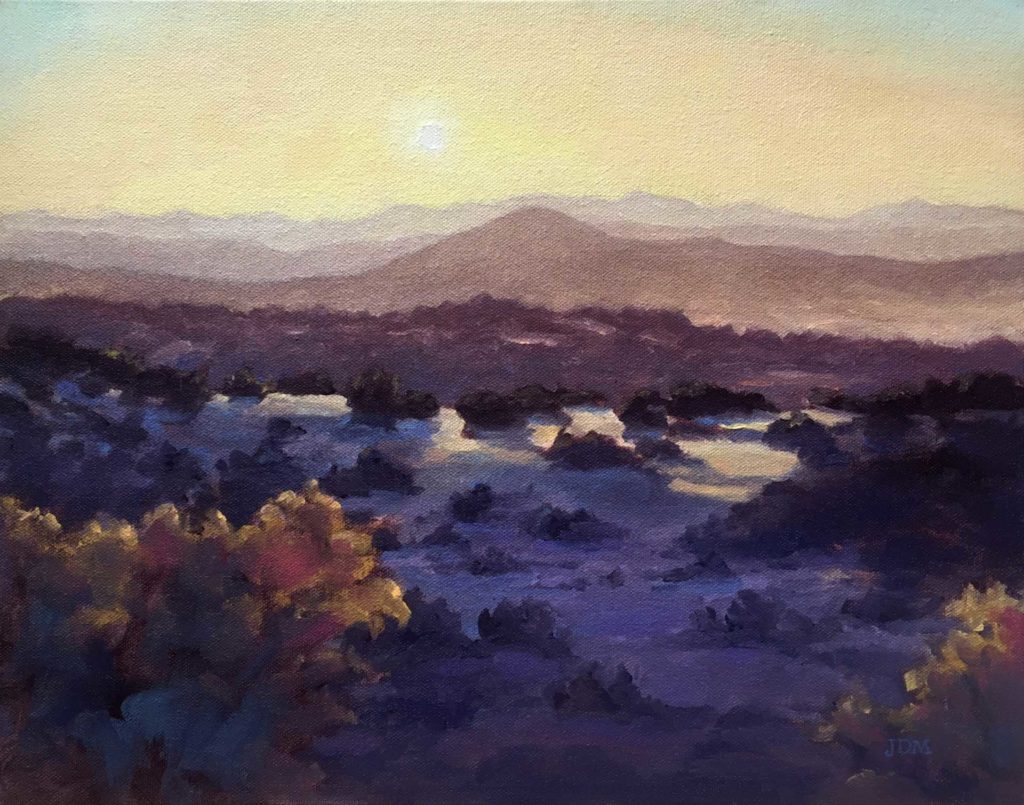
Sunscreen is a very good idea for plein air painting. SPF? Well, a lot. The crisp air feels good here, so it is sometimes easy to forget. A handy jacket for rain and wind is also helpful. Speaking of wind, New Mexicans joke that it’s our fifth season. I find a rock bag or tie-downs useful for my painting set-up.
Breezes here can gust quickly, sending your tripod over the edge of the perfect vantage point or blowing your umbrella back to Albuquerque. On blustery days, I usually place a small rock in my trash bag to keep it from emptying its contents onto the landscape. Plein air painters try to avoid chasing the light, I try to avoid chasing the trash.
We have expressive exposed soils here that can accommodate a wide palette of color. Due to minimal plant life, these soils can be compact or loose, depending on their particular bent. Rain greatly enhances their color and beauty, but what might seem like tolerable precipitation in more verdant places makes a real impact in the sparse desert. It can produce washouts on dirt roads and flash floods in low-lying areas. The good news for painters is that most of our spring rains are not all-day storms. We tend to have localized spotty rains that begin and end quickly, but some can be very focused and intense. Arroyos, the natural creek beds, may appear safe when they are dry, but they formed for a reason. It’s best to stay out of them on wet days because spot storms upstream can send down unexpected floods.
Now, back to pests. Due to the cool dry climate, we generally do not have a lot of biting bugs and mosquitos in early spring. Of course, there is always the exception, depending on where the painter sets up. As the spring rains increase and the air temperature gets warmer, little orbiting clouds of pesky gnats and midges become more common, and occasionally decorate paintings, supporting the tradition of their creation en plein air.
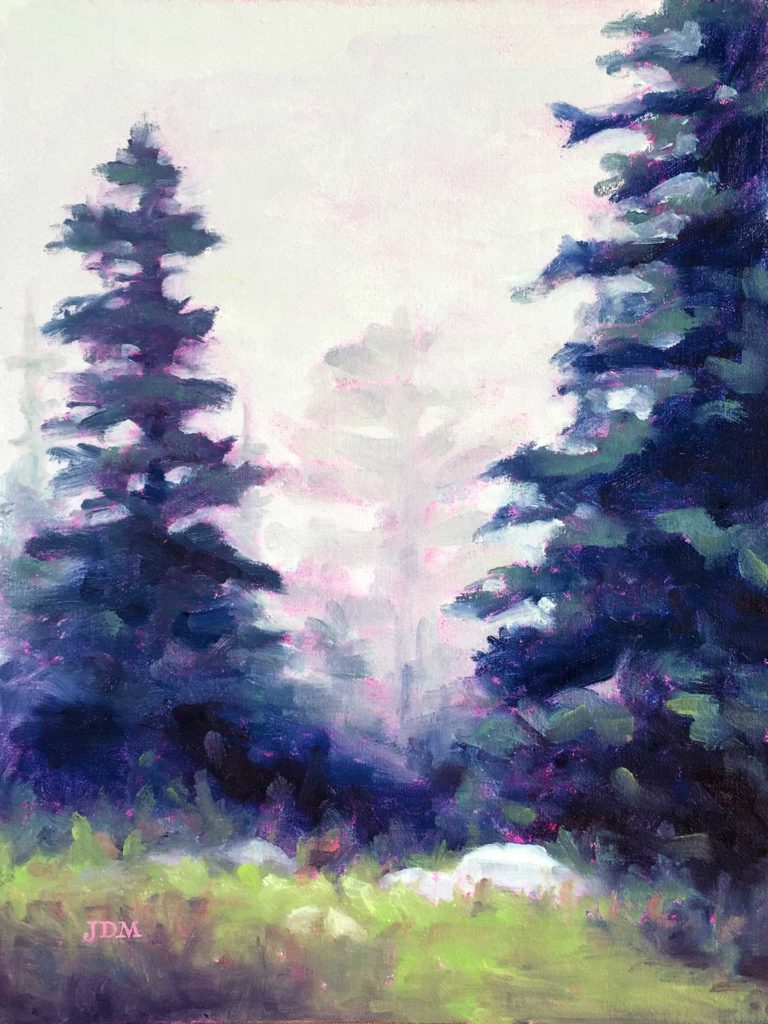
Visitors to the Southwest frequently ask about snakes. When temperatures remain consistently cooler, below 60 degrees or so, snake activity is relatively low. On warmer days, these cold-blooded creatures like to come out of their dens to sun themselves on the warmer rocks. Don’t worry, they are not just lying around everywhere, like a Roman after-party. I have painted outdoors here almost weekly for five years now and have only seen two rattlesnakes in that time. Contrary to what some might think, they will NOT chase you down and bite your legs off. If you see or hear one —their rattle sounds like, “Shhhshhhh . . . shh . . . chh,” just step away from the area and give them a little room. In any case, it’s always a good idea to watch where you step when plein air painting, but you are much more likely to encounter a cactus or critter hole.
This unusual land can be a religious experience for the painter, and to the proud people who were here before us, it is literally that — a religion. Most of the state looks wide open and available to wander onto, but much of it is private ranchland, or belongs to a native pueblo or reservation. Some of these lands are sacred, and access to the public for painting, or even photography, may be forbidden. It is always best to make sure that you have permission to enter and paint in an area that might be questionable.
New Mexico provides the plein air painter with endless opportunities for expression. Even our official state question, “Red or green?” — referring to the color of chile topping your Mexican food, speaks to the artist through complementary colors. When in doubt, just order, “Christmas,” and try both. Then sit by a fireplace or watch the sunset, and let the spell of New Mexico steal your heart.
For the plein air addict, it truly is the Land of Enchantment.
About the author: John Meister lives in Albuquerque, NM. He served as President of Plein Air Painters of New Mexico in 2018 (papnm.org). His work can be found at johnmeisterart.com.
Like this? Click here to subscribe to PleinAir Today,
from the publishers of PleinAir Magazine.

